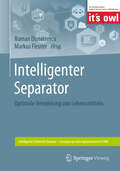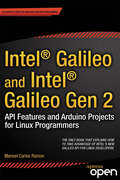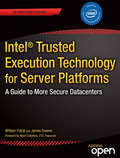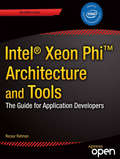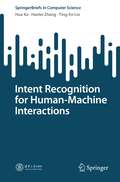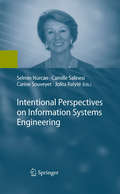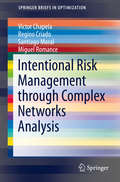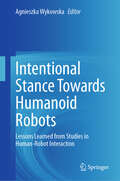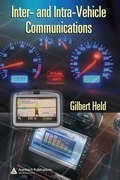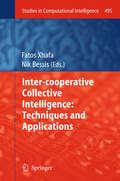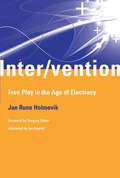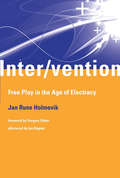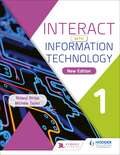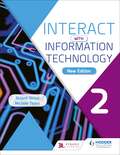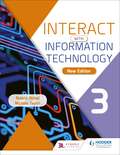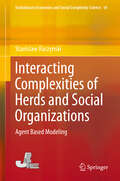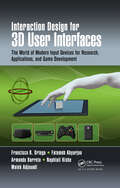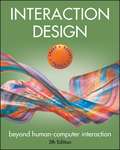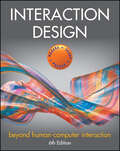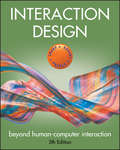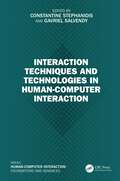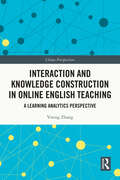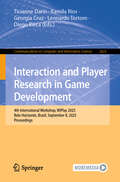- Table View
- List View
Intelligente und nachhaltige Technologie für widerstandsfähige Städte und Gemeinden
by Lakhmi C. Jain Robert J. Howlett John R. Littlewood Marius M. BalasBei diesem Buch handelt es sich um eine Sammlung erweiterter Fassungen von Vorträgen, die auf dem internationalen KES-Gipfel Covid-19 Herausforderung gehalten wurden. Der Schwerpunkt des Buches liegt auf technologischen, wirtschaftlichen und sozialen Entwicklungen zur Bekämpfung der Auswirkungen globaler und lokaler Katastrophen sowie auf der Frage, wie die Erholung von Covid genutzt werden kann, um widerstandsfähigere und nachhaltigere Gemeinschaften und Industrien aufzubauen und die Umwelt zu verbessern. Auch die globalen Herausforderungen des vom Menschen beeinflussten Klimawandels werden erörtert. Die Kapitel befassen sich mit der Stärkung der Widerstandsfähigkeit von Städten und Gemeinden durch Energieautarkie, Lebensmittelproduktion, widerstandsfähige Wohnungen und Gebäude, menschliche Gesundheit und intelligente Systeme, z. B. für Vorhersagen und Prognosen.
Intelligenter Separator: Optimale Veredelung von Lebensmitteln (Intelligente Technische Systeme – Lösungen aus dem Spitzencluster it’s OWL)
by Roman Dumitrescu Markus FleuterDas Buch beinhaltet die Ergebnisse des dreijährigen Verbundprojekts "Separator i4.0" des BMBF-Spitzenclusters it's OWL. Gegenstand des Projekts war die nachhaltige Einbindung von Expertenwissen in die zukunftsweisende Weiterentwicklung und Optimierung von Separationsprozessen. Durch die Entwicklung neuartiger intelligenter Komponenten aus dem Bereich der Sensorik wird es zukünftig möglich sein, Separatoren und die zugehörigen Prozesszusammenhänge zu verstehen und diese ökologisch/ökonomisch optimal auszulegen und zu betreiben. Hierzu wurde ein Instrumentarium bestehend aus Methoden und Lösungen erarbeitet, das darüber hinaus auf analoge Problemstellungen komplexer maschinenbaulicher Anlagen anwendbar sein wird.
Intel® Galileo and Intel® Galileo Gen 2: API Features and Arduino Projects for Linux Programmers
by Manoel Carlos RamonIntel® Galileo and Intel® Galileo Gen 2: API Features and Arduino Projects for Linux Programmers provides detailed information about Intel® Galileo and Intel® Galileo Gen 2 boards for all software developers interested in Arduino and the Linux platform. The book covers the new Arduino APIs and is an introduction for developers on natively using Linux. Author Manoel Carlos Ramon is a member of the Intel Galileo development team; in this book he draws on his practical experience in working on the Galileo project as he shares the team's findings, problems, fixes, workarounds, and techniques with the open source community. His areas of expertise are wide-ranging, including Linux-embedded kernel and device drivers, C/C++, Java, OpenGL, Assembler, Android NDK/SDK/ADK, and 2G/3G/4G modem integration. He has more than 17 years of experience in research and development of mobile devices and embedded circuits. His personal blog about programming is BytesThink (www. bytesthink. com). What you'll learn * How Linux libraries and applications are used and interact with sketches * How to configure WiFi mPCIe * How to develop and debug Intel's Galileo and Intel Galileo Gen 2 sketches using the Arduino IDE, native Linux applications, and hacking * Integration of OpenCV and V4L2 in C/C++/Python to capture picture and videos, and to detect faces, eyes, and your emotional state with a Fisherfaces model * How to exchange data using the 7160 LTE modem * How to tweet with REST API 1. 1 and OAuth authentication * How to control a 6 DOF robot arm using a gripper based in coffee grains, as well as how to create a special API and hardware for six analogic controls * Home Automation with node. js * How to manage temperature sensors, barometric sensors, and PIR motion sensors, as well as how to create your own soil moisture sensors and keypad * How to use a Power of Ethernet (PoE) module on Intel Galileo Gen 2 Who this book is for Software and hardware developers interested in embedded Linux and Arduino. Table of Contents Chapter 1: Intel Galileo Intel Galileo Gen 2 Chapter 2: Native Development Chapter 3: Arduino IDE and the Wiring Language Chapter 4: New APIs and Hacks Chapter 5: Networking and Hacks Chapter 6: Tweeting With REST API 1. 1 Chapter 7: Using OpenCV Chapter 8: Creating a Soil Moisture Sensor Chapter 9: Home Automation and Dynamic Web Chapter 10: Power Over Ethernet (PoE) Chapter 11: Assembling and Controlling a Robotic Arm Chapter 12: Using an LTE Modem Appendix A: Intel Galileo I/O and Muxing Appendix B: Intel Galileo Gen 2 I/O and Muxing Appendix C: Video Capturing Appendix D: Picture Grabber
Intel® Trusted Execution Technology for Server Platforms: A Guide to More Secure Datacenters
by William Futral James Greene"This book is a must have resource guide for anyone who wants to . . . implement TXT within their environments. I wish we had this guide when our engineering teams were implementing TXT on our solution platforms!" John McAuley,EMC Corporation "This book details innovative technology that provides significant benefit to both the cloud consumer and the cloud provider when working to meet the ever increasing requirements of trust and control in the cloud. " Alex Rodriguez, Expedient Data Centers "This book is an invaluable reference for understanding enhanced server security, and how to deploy and leverage computing environment trust to reduce supply chain risk. " Pete Nicoletti. Virtustream Inc. Intel® Trusted Execution Technology (Intel TXT) is a new security technology that started appearing on Intel server platforms in 2010. This book explains Intel Trusted Execution Technology for Servers, its purpose, application, advantages, and limitations. This book guides the server administrator / datacenter manager in enabling the technology as well as establishing a launch control policy that he can use to customize the server's boot process to fit the datacenter's requirements. This book explains how the OS (typically a Virtual Machine Monitor or Hypervisor) and supporting software can build on the secure facilities afforded by Intel TXT to provide additional security features and functions. It provides examples how the datacenter can create and use trusted pools. With a foreword from Albert Caballero, the CTO at Trapezoid. What you'll learn It explains why TXT is important and the underlying principles (why it is effective). How to enable and provision TXT How to create a Launch Control Policy. It discusses trade-offs in determining the right policy for the datacenter, and walks the reader through the process for establishing the policy. Demonstrates how to set up and use trusted pools and other advanced concepts such as geo-tagging. It walks the reader through the process of making Intel TXT work for them and understand that TXT is a building block for current and future enhanced security concepts. Who this book is for The primary audience is the Datacenter Manager and members of an IT organization. It will be valuable to executives that need to understand enhanced server security and will provide a guide to OSVs and ISVs not only to understand the application of TXT but also the new opportunities that TXT enables and ways that the OS and applications can take advantage of those new capabilities. This book applies to cloud computing since TXT can be used to provide additional security for both public and private clouds. Table of Contents Introduction Principals of TXT TXT Provisioning Launch Control Policy Opportunities for the OSV and ISVs Creating a More Secure Data Center Trusted Pools and Cloud Compliance Support Appendix
Intel® Xeon PhiTM Coprocessor Architecture and Tools: The Guide for Application Developers
by Rezaur RahmanIntel#65533; Xeon Phi(tm) Coprocessor Architecture and Tools: The Guide for Application Developers provides developers a comprehensive introduction and in-depth look at the Intel Xeon Phi coprocessor architecture and the corresponding parallel data structure tools and algorithms used in the various technical computing applications for which it is suitable. It also examines the source code-level optimizations that can be performed to exploit the powerful features of the processor. Xeon Phi is at the heart of world's fastest commercial supercomputer, which thanks to the massively parallel computing capabilities of Intel Xeon Phi processors coupled with Xeon Phi coprocessors attained 33. 86 teraflops of benchmark performance in 2013. Extracting such stellar performance in real-world applications requires a sophisticated understanding of the complex interaction among hardware components, Xeon Phi cores, and the applications running on them. In this book, Rezaur Rahman, an Intel leader in the development of the Xeon Phi coprocessor and the optimization of its applications, presents and details all the features of Xeon Phi core design that are relevant to the practice of application developers, such as its vector units, hardware multithreading, cache hierarchy, and host-to-coprocessor communication channels. Building on this foundation, he shows developers how to solve real-world technical computing problems by selecting, deploying, and optimizing the available algorithms and data structure alternatives matching Xeon Phi's hardware characteristics. From Rahman's practical descriptions and extensive code examples, the reader will gain a working knowledge of the Xeon Phi vector instruction set and the Xeon Phi microarchitecture whereby cores execute 512-bit instruction streams in parallel.
Intent Recognition for Human-Machine Interactions (SpringerBriefs in Computer Science)
by Hua Xu Hanlei Zhang Ting-En LinNatural interaction is one of the hottest research issues in human-computer interaction. At present, there is an urgent need for intelligent devices (service robots, virtual humans, etc.) to be able to understand intentions in an interactive dialogue. Focusing on human-computer understanding based on deep learning methods, the book systematically introduces readers to intention recognition, unknown intention detection, and new intention discovery in human-computer dialogue. This book is the first to present interactive dialogue intention analysis in the context of natural interaction. In addition to helping readers master the key technologies and concepts of human-machine dialogue intention analysis and catch up on the latest advances, it includes valuable references for further research.
Intentional Perspectives on Information Systems Engineering
by Selmin Nurcan Jolita Ralyté Carine Souveyet Camille SalinesiRequirements engineering has since long acknowledged the importance of the notion that system requirements are stakeholder goals--rather than system functions--and ought to be elicited, modeled and analyzed accordingly. In this book, Nurcan and her co-editors collected twenty contributions from leading researchers in requirements engineering with the intention to comprehensively present an overview of the different perspectives that exist today, in 2010, on the concept of intention in the information systems community. These original papers honor Colette Rolland for her contributions to this field, as she was probably the first to emphasize that 'intention' has to be considered as a first-class concept in information systems engineering. Written by long-term collaborators (and most often friends) of Colette Rolland, this volume covers topics like goal-oriented requirements engineering, model-driven development, method engineering, and enterprise modeling. As such, it is a tour d'horizon of Colette Rolland's lifework, and is presented to her on the occasion of her retirement at CaISE 2010 in Hammamet, the conference she once cofounded and which she helped to grow and prosper for more than 20 years.
Intentional Risk Management through Complex Networks Analysis
by Victor Chapela Regino Criado Santiago Moral Miguel RomanceThis book combines game theory and complex networks to examine intentional technological risk through modeling. As information security risks are in constant evolution, the methodologies and tools to manage them must evolve to an ever-changing environment. A formal global methodology is explained in this book, which is able to analyze risks in cyber security based on complex network models and ideas extracted from the Nash equilibrium. A risk management methodology for IT critical infrastructures is introduced which provides guidance and analysis on decision making models and real situations. This model manages the risk of succumbing to a digital attack and assesses an attack from the following three variables: income obtained, expense needed to carry out an attack, and the potential consequences for an attack. Graduate students and researchers interested in cyber security, complex network applications and intentional risk will find this book useful as it is filled with a number of models, methodologies and innovative examples.
Intentional Stance Towards Humanoid Robots: Lessons Learned from Studies in Human-Robot Interaction
by Agnieszka WykowskaWith the reinassance of Artificial Intelligence (AI) and AI-empowered technologies, such as robots, we are all asking ourselves the question: What role will these new technologies play in our lives and in our society? On the one hand, we are excited about the new opportunities that AI and robots bring. On the other hand, there are understandable fears: What if the AI becomes too powerful? What if the robots become too human-like? This book is centered around a theoretical framework of the Intentional Stance, initially proposed by Daniel Dennett, and addresses the timely question: How do we, humans, approach robots? Do we see them as intentional agents that can potentially become our social companions? Or do we rather approach them as tools, man-made artifacts? What does it take for a robot to make an impression that it is an intentional/social agent? Is it its appearance? Its behaviour? Or, perhaps (and quite likely), the way it interacts with the human? These questions are addressed across various chapters of book, each of which is then complemented by an inspiring conversation with one of the prominent academics and scholars: Daniel Dennett (Philosophy) – the originator of the concept of the Intentional Stance; Hiroshi Ishiguro (Robotics) – the creator of androids, David Gunkel (Robot-Ethics), Bertram Malle (Cognitive Science), Antonio Sgorbissa (Culturally-competent Social Robotics), Bill Vorn (Robotic Art). The book discusses also some important ethical considerations to be made, and risks to be aware of. Do we actually want to create robots that are treated as intentional agents? What if the line between the human/robot categories becomes blurred? As intentional agents, should robots become also moral agents and legal persons in our societal and legal systems?
Inter- and Intra-Vehicle Communications
by Gilbert HeldThe PC revolution, the advent of PDAs, and growth in the use of wireless LANs have changed the way we live our lives. Next on the horizon is the application of new technologies that will change the way we drive our cars. De rigeur for many drivers, electronic passes and GPS systems represent the tip of the iceberg in terms of emerging applications
Inter-cooperative Collective Intelligence: Techniques and Applications
by Fatos Xhafa Nik BessisThis book covers the latest advances in the rapid growing field of inter-cooperative collective intelligence aiming the integration and cooperation of various computational resources, networks and intelligent processing paradigms to collectively build intelligence and advanced decision support and interfaces for end-users. The book brings a comprehensive view of the state-of-the-art in the field of integration of sensor networks, IoT and Cloud computing, massive and intelligent querying and processing of data. As a result, the book presents lessons learned so far and identifies new research issues, challenges and opportunities for further research and development agendas. Emerging areas of applications are also identified and usefulness of inter-cooperative collective intelligence is envisaged. Researchers, software developers, practitioners and students interested in the field of inter-cooperative collective intelligence will find the comprehensive coverage of this book useful for their research, academic, development and practice activity.
Inter/vention
by Jan Rune Jan Rune HolmevikIn today's complex digital world, we must understand new media expressions and digital experiences not simply as more technologically advanced forms of "writing" that can be understood and analyzed as "texts" but as artifacts in their own right that require a unique skill set. Just as agents seeking to express themselves in alphabetic writing need to be literate, "egents" who seek to express themselves in digital media need to be--to use a term coined by cybertheorist Gregory Ulmer-- electrate. In Inter/vention, Jan Holmevik helps to invent electracy. He does so by tracing its path across the digital and rhetorical landscape--informatics, hacker heuretics, ethics, pedagogy, virtual space, and monumentality--and by introducing play as a new genre of electracy. Play, he argues, is the electrate ludic transversal. Holmevik contributes to the repertoire of electrate practices in order to understand and demonstrate how play invents electracy. Holmevik's argument straddles two divergences: in rhetoric, between how we study rhetoric as play and how we play rhetorically; and in game studies, between ludology and narratology. Games studies has forged ludology practice by distinguishing it from literate practice (and often allying itself with the scientific tradition). Holmevik is able to link ludology and rhetoric through electracy. Play can and does facilitate invention: play invented the field of ludology. Holmevik proposes a new heuretic in which play acts as a conductor for the invention of electracy. Play is a meta behavior that touches on every aspect of Ulmer's concept of electracy.
Inter/vention: Free Play in the Age of Electracy
by Jan Rune HolmevikA proposal that electracy—the special skills needed to navigate and understand our digital world—can be developed through play. In today's complex digital world, we must understand new media expressions and digital experiences not simply as more technologically advanced forms of “writing” that can be understood and analyzed as “texts” but as artifacts in their own right that require a unique skill set. Just as agents seeking to express themselves in alphabetic writing need to be literate, “egents” who seek to express themselves in digital media need to be—to use a term coined by cybertheorist Gregory Ulmer—electrate. In Inter/vention, Jan Holmevik helps to invent electracy. He does so by tracing its path across the digital and rhetorical landscape—informatics, hacker heuretics, ethics, pedagogy, virtual space, and monumentality—and by introducing play as a new genre of electracy. Play, he argues, is the electrate ludic transversal. Holmevik contributes to the repertoire of electrate practices in order to understand and demonstrate how play invents electracy.Holmevik's argument straddles two divergences: in rhetoric, between how we study rhetoric as play and how we play rhetorically; and in game studies, between ludology and narratology. Games studies has forged ludology practice by distinguishing it from literate practice (and often allying itself with the scientific tradition). Holmevik is able to link ludology and rhetoric through electracy.Play can and does facilitate invention: play invented the field of ludology. Holmevik proposes a new heuretic in which play acts as a conductor for the invention of electracy. Play is a meta behavior that touches on every aspect of Ulmer's concept of electracy.
Interact with Information Technology 1 new edition
by Michele Taylor Roland BirbalProvide an accessible approach to theory and practice with this new edition updated to comprehensively cover recent IT developments and the latest Caribbean curricula for Forms 1 to 3 (Grades 7 to 9).- Consolidate learning through a range of question types such as Multiple Choice, True or False, Short Answer and a fun Crossword puzzle.- Build critical thinking and project work skills with research and STEM projects using real life situations.- Develop understanding with new topics covered such as computer ethics, algorithm development, emerging careers.The answers can be found here: www.hoddereducation.co.uk/interactanswers
Interact with Information Technology 2 new edition
by Michele Taylor Roland BirbalProvide an accessible approach to theory and practice with this new edition updated to comprehensively cover recent IT developments and the latest Caribbean curricula for Forms 1 to 3 (Grades 7 to 9).- Consolidate learning through a range of question types such as Multiple Choice, True or False, Short Answer and a fun Crossword puzzle.- Build critical thinking and project work skills with research and STEM projects using real life situations.- Develop understanding with new topics covered such as computer ethics, algorithm development, emerging careers.The answers can be found here: www.hoddereducation.co.uk/interactanswers
Interact with Information Technology 3 new edition
by Michele Taylor Roland BirbalProvide an accessible approach to theory and practice with this new edition updated to comprehensively cover recent IT developments and the latest Caribbean curricula for Forms 1 to 3 (Grades 7 to 9).- Consolidate learning through a range of question types such as Multiple Choice, True or False, Short Answer and a fun Crossword puzzle.- Build critical thinking and project work skills with research and STEM projects using real life situations.- Develop understanding with new topics covered such as computer ethics, algorithm development, emerging careers.The answers can be found here: www.hoddereducation.co.uk/interactanswers
Interacting Complexities of Herds and Social Organizations: Agent Based Modeling (Evolutionary Economics and Social Complexity Science #19)
by Stanislaw RaczynskiThis book presents examples of and the latest simulation studies on artificial societies and populations, highlighting innovative implementations of various models of artificial societies and populations using a new, C++-related simulation tool. It demonstrates that the prey-predator models—including spatial distribution, moving patterns, limited renewable food, fear, gregarious (herd) instinct, clustering, epidemics, and competition—are more complex than other publications have suggested, and highlights the great discrepancy between agent-based and conventional continuous models. The book also discusses the modeling and simulation of self-organization and interactions between organizations, including terror organizations, offering fascinating insights into organizational dynamics. The book provides a broad range of examples and comparisons with the classical dynamics approach, showing readers how to construct models of complex systems. It starts with descriptions of the behavior of interacting individuals and also includes important information on the macro-behavior of the whole system.
Interaction Design for 3D User Interfaces: The World of Modern Input Devices for Research, Applications, and Game Development
by Francisco R. Ortega Fatemeh Abyarjoo Armando Barreto Naphtali Rishe Malek AdjouadiThis book addresses the new interaction modalities that are becoming possible with new devices by looking at user interfaces from an input perspective. It deals with modern input devices and user interaction and design covering in-depth theory, advanced topics for noise reduction using Kalman Filters, a case study, and multiple chapters showing hands-on approaches to relevant technology, including modern devices such as the Leap-Motion, Xbox One Kinect, inertial measurement units, and multi-touch technology. It also discusses theories behind interaction and navigation, past and current techniques, and practical topics about input devices.
Interaction Design: Beyond Human-Computer Interaction
by Helen Sharp Jenny Preece Yvonne Rogers Jennifer PreeceHugely popular with students and professionals alike, the Fifth Edition of Interaction Design is an ideal resource for learning the interdisciplinary skills needed for interaction design, human-computer interaction, information design, web design, and ubiquitous computing. New to the fifth edition: a chapter on data at scale, which covers developments in the emerging fields of 'human data interaction' and data analytics. The chapter demonstrates the many ways organizations manipulate, analyze, and act upon the masses of data being collected with regards to human digital and physical behaviors, the environment, and society at large. <p><p> Revised and updated throughout, this edition offers a cross-disciplinary, practical, and process-oriented, state-of-the-art introduction to the field, showing not just what principles ought to apply to interaction design, but crucially how they can be applied.
Interaction Design: Beyond Human-Computer Interaction
by Helen Sharp Yvonne Rogers Jennifer PreeceA delightful, engaging, and comprehensive overview of interaction design Effective and engaging design is a critical component of any digital product, from virtual reality software to chatbots, smartphone apps, and more. In the newly updated sixth edition of Interaction Design: Beyond Human-Computer Interaction, a team of accomplished technology, design, and computing professors delivers an intuitive and instructive discussion of the principles underlying the design of effective interactive technologies. The authors discuss how to design and apply digital technologies in the real world, illustrated with numerous examples. The book explores the interdisciplinary foundations of interaction design, including skills from product design, computer science, human and social psychology, and others. The book builds on the highly successful fifth edition and draws on extensive new research and interviews with accomplished professionals and researchers in the field that reflect a rapidly-changing landscape. It is supported by a website hosting digital resources that add to and complement the material contained within. Readers will also find: Explorations of the social and emotional components of interacting with apps, digital devices and computers Descriptions about how to design, prototype, evaluate and construct technologies that support human-computer interaction Discussions of the cognitive aspects of interaction design, as well as design and evaluation, including usability testing and expert reviews. An essential text for undergraduate and graduate students of human-computer interaction, interaction design, software engineering, web design, and information studies, Interaction Design will also prove to be indispensable for interaction design and user experience professionals.
Interaction Design: Beyond Human-Computer Interaction (Ics Ser.)
by Helen Sharp Yvonne Rogers Jennifer PreeceA new edition of the #1 text in the human computer Interaction field! Hugely popular with students and professionals alike, the Fifth Edition of Interaction Design is an ideal resource for learning the interdisciplinary skills needed for interaction design, human-computer interaction, information design, web design, and ubiquitous computing. New to the fifth edition: a chapter on data at scale, which covers developments in the emerging fields of 'human data interaction' and data analytics. The chapter demonstrates the many ways organizations manipulate, analyze, and act upon the masses of data being collected with regards to human digital and physical behaviors, the environment, and society at large. Revised and updated throughout, this edition offers a cross-disciplinary, practical, and process-oriented, state-of-the-art introduction to the field, showing not just what principles ought to apply to interaction design, but crucially how they can be applied. Explains how to use design and evaluation techniques for developing successful interactive technologies Demonstrates, through many examples, the cognitive, social and affective issues that underpin the design of these technologies Provides thought-provoking design dilemmas and interviews with expert designers and researchers Uses a strong pedagogical format to foster understanding and enjoyment An accompanying website contains extensive additional teaching and learning material including slides for each chapter, comments on chapter activities, and a number of in-depth case studies written by researchers and designers.
Interaction Techniques and Technologies in Human-Computer Interaction
by Gavriel Salvendy Constantine StephanidisThis book offers a thorough exploration of interaction design by examining various technologies,interaction techniques, styles, and devices.This book• Assists readers in acquiring a deep understanding of diverse ways humans interact withcomputer technologies and in selecting the most suitable approach for various interactivescenarios.• Introduces cutting‑edge interaction techniques, including multimodal and gesture‑basedinteraction, wearables, haptic, speech and sound‑based interaction, embodied interaction,and more.• Advances beyond traditional interfaces to large and multiscreen interactions, proxemics,brain‑computer interfaces, affective computing and Extended Reality.This book will appeal to individuals interested in Human-Computer Interaction research andapplications.
Interaction and Knowledge Construction in Online English Teaching: A Learning Analytics Perspective (China Perspectives)
by Yining ZhangWithin a Chinese English as a Foreign Language (EFL) learning context, this book investigates how teachers and learners interacted and articulated their understanding of English for Research Publication Purposes (ERPP)-related knowledge in a synchronous EFL classroom.The outbreak of the COVID-19 Pandemic changed the way people receive education, causing an almost overnight switch from on-campus instruction to distance learning. Under the use of three different learning analytics approaches, this book has moved beyond the usual descriptive understanding of the online learning process to an in-depth exploratory and inferential analysis of the entities, structures, relations, and processes of learning. The findings enrich current understandings of the complexity of ERPP teaching and learning in synchronous learning contexts. These findings also drive us to rethink and reshape the way ERPP instruction is delivered post-pandemic. An essential read for students and scholars of education and academic English. This book will also be a vital source for researchers in the field of learning analytics, data analysis, and data interpretation in language teaching and learning.
Interaction and Knowledge Construction in Online English Teaching: A Learning Analytics Perspective (China Perspectives)
by Yining ZhangWithin a Chinese English as a Foreign Language (EFL) learning context, this book investigates how teachers and learners interacted and articulated their understanding of English for Research Publication Purposes (ERPP)-related knowledge in a synchronous EFL classroom.The outbreak of the COVID-19 pandemic changed the way people receive education, causing an almost overnight switch from on-campus instruction to distance learning. Under the use of three different learning analytics approaches, this book has moved beyond the usual descriptive understanding of the online learning process to an in-depth exploratory and inferential analysis of the entities, structures, relations, and processes of learning. The findings enrich current understandings of the complexity of ERPP teaching and learning in synchronous learning contexts. These findings also drive us to rethink and reshape the way ERPP instruction is delivered post-pandemic.An essential read for students and scholars of education and academic English. This book will also be a vital source for researchers in the field of learning analytics, data analysis, and data interpretation in language teaching and learning.
Interaction and Player Research in Game Development: 4th International Workshop, WIPlay 2025, Belo Horizonte, Brazil, September 8, 2025, Proceedings (Communications in Computer and Information Science #2623)
by Ticianne Darin Kamila Rios Georgia Cruz Leonardo Tórtoro Diego RiccaThis book constitutes the proceedings of the 4th International Workshop on Interaction and Player Research in Game Development, WIPlay 2025, which took place in Belo Horizonte, Brazil, in September 2025. The 10 full papers and 2 full papers included in this book were carefully reviewed and selected from 15 submissions. They were organized in topical sections as follows: Socially Conscious and inclusive game design; ethical game design and responsible gaming; and practical methods and frameworks for game design and evaluation.

